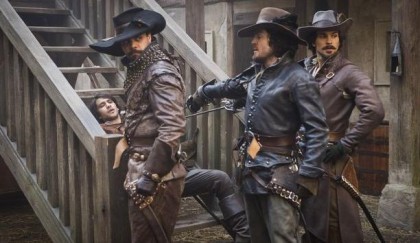Appendix
The appendix includes tips for playing a swashbuckler boiling down to it revolves around attitude more than any specific set of skills or abilities. Several ‘archetypes’ are listed including masked avengers, pirates, and more. Each brief description describes what a character should be able to do, but they are not mutually exclusive. Following their advice on archetypes, it includes a dozen or so NPC classes to represent typical opposition. Each covers 5 levels, but the differences between them are minute. The difference between a +1/2 and +1/3 BAB and a d8 and d8 aren’t easy to notice.
Finally, it includes a map of each nation with each notable city marked. In the case of Montaigne, that is 19 cities, so 16 more than they mentioned in the ‘notable settlements chapter’.
The Swashbuckling Adventures Line ended up supporting 11 books with good binding and generally good production values. In a lot of ways, 3.x was a good enough system that for low-level play you could manage a fair approximation of a Swashbuckling system – skills and feats could allow some types of archetypal characters that just weren’t really possible in 2nd edition. But ultimately it boils down to a few paragraphs of rather obvious and generic advice and a lot of words on mechanics that don’t really support the genre.
Since this was a Campaign Setting book, I really expected more on the actual setting. The book doesn’t provide a compelling reason why someone would choose to play in Théah as opposed to the real-world. Within this book, the ideas that are covered are not fleshed out.

Which, to be fair, isn’t ENTIRELY contrary to the aesthetics of the source material
So what went wrong?
The biggest thing is trying to outline an entire world in ~250 pages. Frommer’s Guide to Paris is over 300 pages and they’re focused entirely on places you might want to visit without directly covering 4,000+ years of human occupation. They simply weren’t able to provide enough information about anything they discussed to help a GM prepare an adventure around it. If you had just read the
Count of Monte Cristo (and you should – it’s one of my favorite novels) you’d be able to create an island prison adventure just fine – you wouldn’t have to decide if you were setting it in France or Italy or what have you… Essentially, this is an example of top-down world building – they drew a map, decided what cultures they wanted to include, assigned everything to a place and talked about it for as much time and space they allowed.
To build campaign setting that enables Swashbuckling, it would have been better to start with a single place that encourages as much of the source material as you can imagine. A port city with a significant privateer/pirate presence, some political machinations, nobles with cadres of private guards, a dash of religious dissent and an autocratic ruler trying to assert his power over the people would have been a better use of space. It would have given the authors a chance to talk about mercenary refugees from Eisen
in a way that showed how they could be used in a swashbuckling adventure. There were no tips for how a GM could build an encounter with terrain effects that allows for stunts. Can a PC pick up and throw a bench into 3 guards as they charge into the room? If they can, how is it resolved? Is it just a damage? Or does it count as a trip attack?

We know Musketeers LOOK cool, but how do we actually make them ACT cool
Without at least a place to let the players hang their hats and participate in society, we don’t really have enough to run a game.
Perhaps most damning, the examples of classic swashbucklers referenced in this book are
primarily heroic
individuals. How to make a swashbuckling adventure with 4+ adventurers with different strengths and weaknesses isn’t even discussed.
Ultimately, what this
ought to have been was a lot more like
Freeport: The City of Adventure also published in 2002. Published a few months earlier, it’s an example of a setting book that gives people a place, a reason, and ways to adventure – at least, that’s how I remember it. I’ll do a review of it in the near future to see if memory serves.

Not to be confused with the 2006 version updated for 3.5 that had the Wayne Reynolds cover



